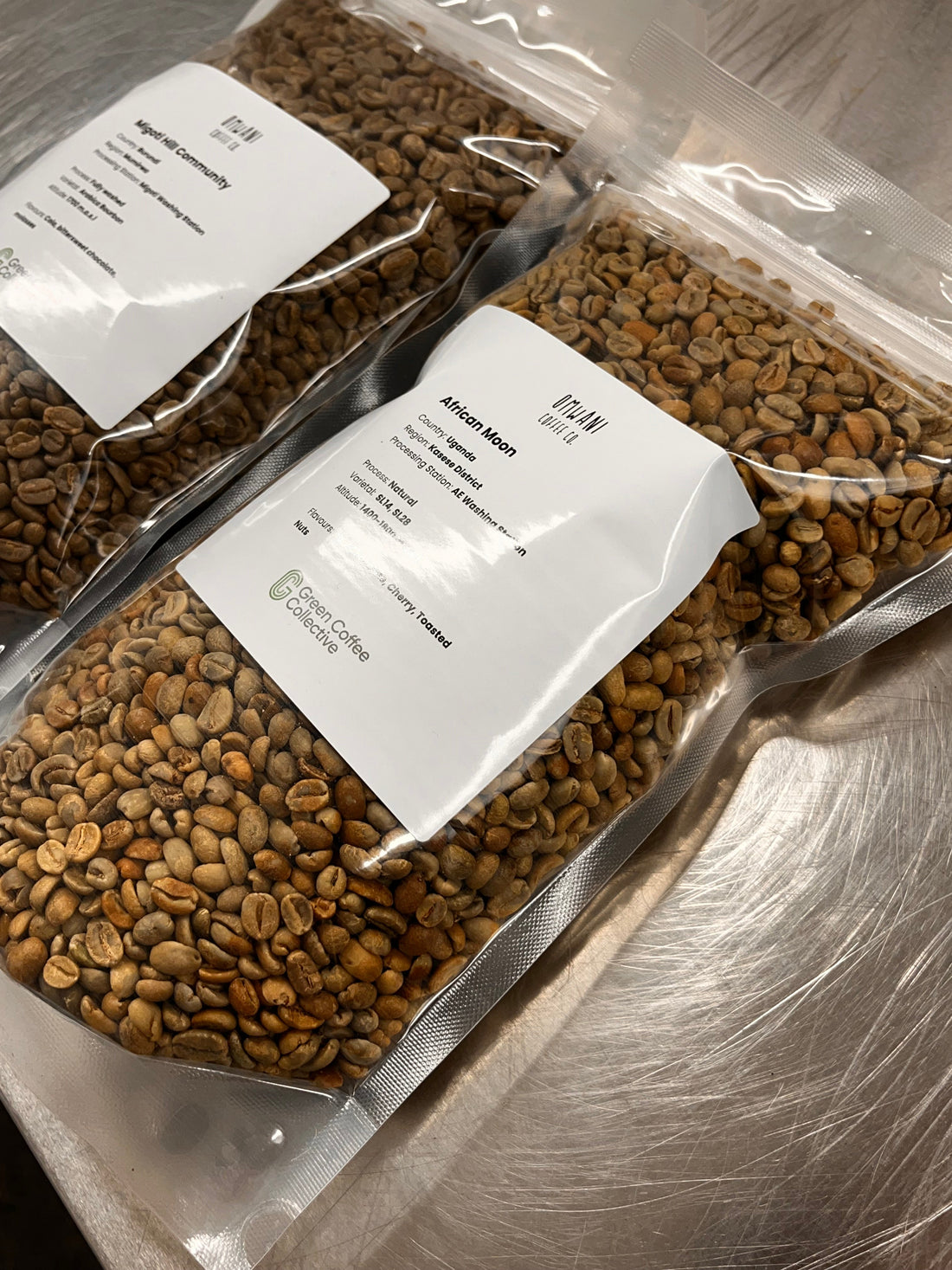Imagine waking up to the rich aroma of freshly roasted coffee wafting through your home. You don’t have to be a coffee connoisseur to enjoy this sensory delight; you can roast green coffee beans right in your kitchen.
The magic of roasting lies in transforming raw, green beans into those familiar brown gems that brew a perfect cup. It’s easier than you think, and doing it yourself means you control the taste, aroma, and freshness of every sip.
Plus, there’s something deeply satisfying about crafting your own coffee blend. In this guide, you’ll discover simple steps to roast green coffee beans at home, unlocking flavors and aromas that will elevate your coffee experience. Curious to master this art? Keep reading to learn how!
Choosing The Right Green Coffee Beans
Selecting the best green coffee beans is crucial for roasting success. The right beans ensure a flavorful and satisfying cup. Different beans offer unique flavors and aromas. Understand their origin, type, and processing method. This knowledge helps you make an informed choice.
Understanding Coffee Origins
Coffee grows in various regions worldwide. Each region imparts distinct flavors to the beans. African beans often taste fruity and bright. South American beans are known for chocolatey and nutty notes. Asian beans can have earthy and spicy flavors. Knowing these differences guides your selection.
Types Of Coffee Beans
Two main types of coffee beans exist: Arabica and Robusta. Arabica beans offer a smoother, milder taste. They are less bitter than Robusta. Robusta beans have a stronger, more bitter flavor. Choose based on your taste preference. Many prefer Arabica for its sweet and soft flavor.
Processing Methods
Beans undergo different processing methods. These methods affect their final taste. Washed beans have a clean and bright taste. Natural processed beans offer a fruity and complex profile. Honey processed beans combine both characteristics. They have a balanced taste with sweetness.
Bean Freshness
Freshness plays a critical role in coffee quality. Always check the harvest date. Fresher beans result in a better roast. They retain more flavor and aroma. Aim for beans harvested within the last year.
Organic And Ethical Considerations
Consider organic and ethically sourced beans. They are often higher in quality. Organic beans are grown without harmful chemicals. Ethically sourced beans support fair trade practices. Choose these for a more sustainable choice.

Credit: greencoffeecollective.com
Essential Equipment For Home Roasting
Roasting green coffee beans at home can be a rewarding experience. The aroma, the crackling sound, and the anticipation of fresh coffee are exciting. To get started, you need some essential equipment. Each piece plays a crucial role in achieving the perfect roast.
1. Green Coffee BeansChoose high-quality green coffee beans. Their quality affects the final cup. Experiment with beans from different regions. Each offers unique flavors and aromas. Store them in a cool, dry place.
2. Roasting MachineA roasting machine is key. Air roasters and drum roasters are popular choices. Air roasters use hot air to roast beans. They are fast and efficient. Drum roasters provide a more traditional roast. Each machine offers different features.
3. ThermometerA thermometer is necessary to monitor temperature. Consistent heat is vital for a good roast. Keep an eye on the temperature during the process. It ensures even roasting and prevents burning.
4. TimerUse a timer to track roast time. Different stages of roasting require specific times. Timing affects the flavor and aroma. Ensure you roast beans for the right duration.
5. ColanderA colander helps cool beans quickly. After roasting, beans continue to cook. Cooling them fast preserves their flavor. Shake them in a colander to remove chaff.
6. Storage ContainersStore roasted beans in airtight containers. This keeps them fresh and flavorful. Glass or ceramic containers work best. Avoid storing beans in direct sunlight.
Different Methods Of Roasting
Roasting green coffee beans at home offers a rewarding experience. Exploring different methods can help you find the perfect roast. Each technique brings its unique charm. Discover how to roast using simple tools and equipment you might already have.
Stovetop Popcorn Popper
Using a stovetop popcorn popper is a popular choice. The manual stirring mechanism ensures even heat distribution. Place the popper on the burner and set it to medium heat. Constantly stir the beans for 8-10 minutes. Listen for the first crack. It signals that roasting is in progress. Adjust the heat if necessary to achieve desired roast. This method is simple and cost-effective.
Oven Roasting
Oven roasting is another easy method. Preheat your oven to 450°F (230°C). Spread coffee beans evenly on a baking sheet. Place them on the center rack. Roast for 15-20 minutes while stirring occasionally. Monitor closely for color change and aroma. The first crack might be faint due to the enclosed space. Remove beans when they reach the desired roast level. This method uses equipment already in most kitchens.
Home Coffee Roaster
Investing in a home coffee roaster offers precision. These devices are designed specifically for roasting coffee. Set the desired temperature and time. Add green beans and start the machine. Most home roasters have adjustable settings for different roast levels. This method provides consistency and control. It is ideal for those who prefer a perfect cup each time.
Preparing Your Workspace
Creating the right environment is key for roasting green coffee beans. Ensure good ventilation and have necessary tools ready, like a pan or roaster. Organize your space to easily manage beans and monitor their progress.
Roasting green coffee beans at home is a rewarding experience that fills your space with the rich aroma of freshly roasted coffee. But before you start, it’s crucial to prepare your workspace effectively. A well-organized area can be the difference between a smooth roasting session and a chaotic coffee mess.Setting Up Your Roasting Area
Begin by choosing a spot in your kitchen or garage where you can comfortably work. Ensure it’s well-ventilated, as roasting coffee beans releases smoke and chaff. Place your roasting equipment within easy reach, whether it’s a popcorn popper or a dedicated coffee roaster. Keep a clean surface handy for cooling beans post-roast.Gather Your Tools
You’ll need a few essentials: green coffee beans, a roasting appliance, and a cooling tray. Consider using a kitchen scale for precise measurements. Don’t forget a timer to track your roast duration. Having these tools ready helps streamline the process and prevents unnecessary interruptions.Organizing Your Space
Arrange your equipment logically—beans on one side, roasting device centrally placed, and cooling area on the other. This setup minimizes movement, allowing you to focus on the roast itself. Keep a cloth or brush nearby to clean up chaff and spills instantly.Ensuring Safety
Check your workspace for any hazards. Ensure electrical cords aren’t tangled or stretched across walkways. Be mindful of the heat generated during roasting and keep flammable items away from your setup. Safety should be a priority, so you can enjoy your coffee without stress.Creating The Right Atmosphere
Finally, make your roasting experience enjoyable. Play some music or listen to a podcast as you roast. The ambiance can enhance the process, making it a delightful ritual rather than a mere task. Have you ever felt the transformative power of a well-prepared workspace? By arranging your area thoughtfully, you’re not just roasting coffee—you’re crafting an experience.Understanding The Roasting Process
Roasting green coffee beans at home is simple and rewarding. Use a pan or oven to heat beans evenly. Listen for the first crack to know they’re ready. Enjoy fresh, aromatic coffee.
Roasting green coffee beans at home is a fascinating journey into the heart of your daily brew. It’s not just about heating the beans; it’s an art that unfolds through distinct stages. Understanding the roasting process empowers you to tailor your coffee to your taste preferences. You might be surprised at how much control you have over the final flavor.First Crack
The first crack is a pivotal moment in roasting. As the beans heat up, you’ll hear a cracking sound, similar to popcorn popping. This signifies the beans are reaching a light roast. Have you ever noticed how your coffee tastes different every time you buy from a new place? The first crack explains a lot about that flavor difference. It’s where you decide whether you want a bright, fruity coffee or something deeper.Second Crack
The second crack is a game-changer. It indicates the transition from medium to dark roast. The sound is softer than the first crack, but it’s equally important. This stage is where many people find their perfect cup. Do you prefer a robust, bold flavor? Waiting for the second crack might just get you there. But be cautious; beyond this point, the beans can quickly turn bitter.Cooling The Beans
Cooling is crucial to stop the roasting process. Once the beans hit your desired roast level, swiftly transfer them to a metal colander or baking tray. Have you ever wondered why some coffee tastes burnt? It’s often because the beans weren’t cooled quickly enough. Rapid cooling preserves the flavor and aroma you’ve worked hard to achieve. Roasting at home is an adventure of flavors. Each stage offers a chance to experiment and discover what you love in your coffee. What will your perfect roast be?
Credit: pratter.co.id
Timing And Temperature Considerations
Roasting green coffee beans at home requires careful attention to timing and temperature. Keep the heat between 370°F and 540°F. Adjust the roasting time to achieve your desired flavor profile.
Roasting green coffee beans at home is an exciting venture that allows you to control the flavor of your coffee. Timing and temperature are crucial elements in the roasting process. They dictate the final taste and aroma of your brew. How long you roast and at what heat can transform your coffee from a light, fruity note to a dark, rich flavor. Let’s dive into the specifics of timing and temperature to ensure your home roasting experience yields the perfect cup.Understanding The Ideal Roasting Time
Time is your ally in the roasting process. Shorter roasting times generally produce a lighter roast, preserving more of the bean’s natural flavors. Longer roasting times can lead to a darker roast with more bitterness. Do you prefer a bright, acidic cup or a deep, bold flavor? Your choice will guide how long you roast your beans. Aim for a light roast if you’re after complex flavors. Extend the time for a richer, full-bodied brew.Temperature Settings For Different Roast Levels
Temperature control is key to achieving your desired roast level. Generally, lighter roasts require lower temperatures around 350°F to 400°F. For medium roasts, you might increase the heat to 400°F to 430°F. Dark roasts, those rich and bold, demand higher temperatures above 430°F. Finding the right temperature is like finding the sweet spot in cooking. Start at a lower temperature and slowly increase. Watch how your beans change color and smell. This gradual approach prevents burning and helps develop the nuanced flavors.Combining Timing And Temperature
Timing and temperature work hand-in-hand. Adjusting one affects the other. A higher temperature can shorten roasting time, but it may lead to uneven roasting. Lower temperatures require patience but allow for better control. Experiment with different combinations to find what suits your taste. Keep a journal of your roasting experiences. Note the time, temperature, and results. This record will help you refine your technique, making each batch better than the last.Recognizing The Signs Of A Perfect Roast
Your senses are your best tools in recognizing a perfect roast. Listen for the first crack—it’s a sign your beans are reaching the light roast phase. A second crack signals a medium to dark roast. Visual cues are equally important. Light roasts will be tan in color, while dark roasts will appear oily and dark brown. Smell the beans; they should have a pleasant aroma, not a burnt scent.Experiment And Enjoy The Process
Every roast is an opportunity to learn and perfect your technique. Try different beans and roasting methods. Discover the unique flavors that emerge from each batch. Are you ready to embark on a flavorful journey? Roasting coffee at home is not just about the brew; it’s about the experience. Your kitchen becomes a laboratory for creating taste, and each cup is a reward for your curiosity and effort.Storing And Resting Roasted Beans
Roasted beans need proper storage to preserve their flavor. Airtight containers keep them fresh and aromatic. Let beans rest for a few days to enhance taste.
Roasting green coffee beans at home is a rewarding experience. Once roasted, proper storage and resting are crucial. These steps ensure the best flavor and aroma. Learn how to keep your beans fresh and flavorful below.How To Store Roasted Coffee Beans
Roasted beans need a cool, dark place. Use airtight containers to keep them fresh. Mason jars or specialized coffee containers work well. Avoid clear containers. Light can spoil the beans.Why Resting Roasted Coffee Beans Matters
Resting allows flavors to develop. Freshly roasted beans release gases. This process is called degassing. It takes 12 to 72 hours. Resting enhances taste and aroma.The Ideal Time For Resting Coffee Beans
Most beans need 24 to 48 hours of rest. Some may require up to 72 hours. Experiment to find your perfect timing. Every roast and bean type can differ.Signs Of Properly Rested Coffee Beans
Well-rested beans smell rich and aromatic. The taste should be smooth and balanced. Over-resting may lead to stale flavors. Always check for freshness before use.Troubleshooting Common Issues
Roasting green coffee beans at home can be tricky. Beans may roast unevenly, causing inconsistent flavors. Adjusting roast time and temperature helps achieve uniformity.
Roasting coffee beans at home can be rewarding. But, it often comes with challenges. Knowing how to fix these issues is crucial. It ensures a perfect cup of coffee. Let’s discuss some common problems. We’ll explore ways to solve them.Uneven Roasting
Uneven roasting happens often. Different parts of beans roast at different rates. This affects flavor. Check the temperature first. The heat source might be too low. Stir the beans regularly. It helps distribute heat evenly. Use a thermometer to monitor the temperature. Consistent stirring and even heat are key.Over-roasting
Over-roasting makes beans taste bitter. It also darkens their color too much. Reduce the roasting time immediately. Watch the beans closely. Listen for the second crack. That’s a sign to stop roasting. Cooling the beans quickly helps too. Spread them on a baking sheet. This prevents further cooking.Under-roasting
Under-roasting leaves beans grassy. They also taste sour. Increase the roasting time slightly. Use a higher temperature if needed. Listen for the first crack. It’s essential for proper roasting. Ensure beans are in the heat long enough. Remember, practice makes perfect. Adjust until you find the right balance. `Experimenting With Roasting Profiles
Experimenting with roasting profiles can be an exciting journey. Each profile brings out unique flavors in your coffee. As you roast green beans at home, adjusting time and temperature makes a big difference. This exploration helps you discover your preferred taste. With practice, you’ll become adept at creating different profiles. It’s a blend of art and science that offers endless possibilities.
Understanding Roasting Profiles
Roasting profiles are guides that detail time and temperature settings. They help achieve desired flavor and aroma. Some profiles emphasize sweetness, while others focus on acidity. Experimenting with profiles lets you find what suits your palate best. Understanding these profiles is key to mastering the art of coffee roasting.
Adjusting Time And Temperature
The roasting time affects the flavor greatly. Shorter roasts often result in brighter coffee. Longer roasts can produce deeper, richer flavors. Temperature plays a crucial role too. Higher temperatures may lead to stronger, bolder tastes. Lower temperatures often create milder coffee. Balancing these elements is essential in creating your ideal coffee profile.
Recognizing Coffee Bean Changes
As beans roast, they undergo visible changes. They start green and end brown. The surface becomes more oily as roasting progresses. Listening for the first and second crack is vital. The first crack signifies light roast. The second crack indicates a darker roast. Observing these changes helps in adjusting your roasting profile.
Documenting Your Roasting Experiments
Keep track of each roasting session. Note down time, temperature, and bean changes. Documenting helps identify which profiles work best. It allows you to refine your methods over time. This record is invaluable in understanding how different profiles affect flavor. Sharing these notes with other coffee enthusiasts can also be rewarding.

Credit: sichuankitchenrecipes.com
Frequently Asked Questions
How To Start Roasting Green Coffee Beans?
Begin by selecting quality green coffee beans. Preheat your roaster or pan to around 400°F. Add beans and stir continuously for even roasting. Monitor color and aroma changes to achieve desired roast level. Cool beans immediately after roasting to preserve flavor.
Enjoy your freshly roasted coffee!
What Equipment Is Needed For Home Roasting?
Home roasting requires a reliable roaster or pan, a thermometer, and a cooling tray. Choose a roaster suitable for your space and budget. A pan can work for small batches. Ensure you have a ventilation system to manage smoke. Cooling trays help preserve flavor and prevent over-roasting.
How Long To Roast Green Coffee Beans?
Roasting time varies from 10 to 15 minutes. Light roasts take around 10 minutes, while darker roasts need more time. Monitor beans for desired color and aroma. Stir constantly for even heat distribution. Always cool beans quickly to prevent further roasting and flavor loss.
Can I Roast Coffee Beans Without A Machine?
Yes, you can roast coffee beans without a machine. Use a stovetop pan or oven. Preheat your pan and add beans, stirring constantly. Monitor color changes to achieve your preferred roast level. Alternatively, use an oven and spread beans on a baking sheet.
Cool beans immediately after roasting.
Conclusion
Roasting green coffee beans at home is simple and rewarding. Freshly roasted coffee tastes better. You control the flavor. Choose your preferred roast level. Light, medium, or dark. Experiment with different techniques. Use a popcorn maker, oven, or stovetop. Enjoy the aroma filling your kitchen.
Share your roasted coffee with friends. A personal touch in every cup. Tastes unique and homemade. Save money on store-bought beans. Gain a new hobby. Make it part of your routine. Discover the joy of roasting. Savor each sip. Start today.
Enjoy your coffee journey!






